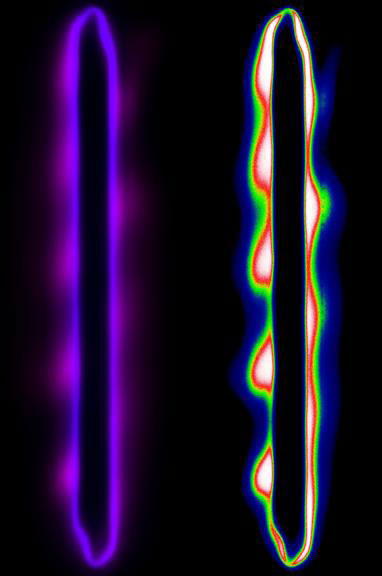SCI engineer puts head in ion clouds

While clouds in the sky can dampen our mood or even our plans for the day, ion “clouds” that form in rotary cathode vacuum chambers can potentially have a negative effect on the sputtering process.
Although these ion clouds appear to have little or no influence on coating uniformity, targets erode at a greater rate where there are ion clouds, adversely affecting target utilization and thus process efficiency.
Patrick Morse, senior applications and development engineer at Sputtering Components, is studying these ion clouds and presented his early findings at the Society of Vacuum Coaters Conference in Rhode Island earlier this year.
Also known as “spokes” (Anders) or “local ionization zones” (Janes and Lowder), ion clouds are bright spots in the plasma. With research focused on DC magnetrons with small, disc targets, they were said to rotate around the plasma “racetrack” and were known to relate to discharge power density.
But with the thin film industry using stronger magnetic fields for confining the plasma on large-area rotary magnetrons, ionization clouds became visible to the naked eye, and Morse’s interest piqued. He found other factors that influenced ion cloud formation and came up with a model and formula that predicts when they will occur.
Besides discharge power, Morse discovered that ion cloud formation also depends on process gas pressure, chamber geometry, the type of target material, and the magnetron magnetic field strength.
Furthermore, using high speed thermal video, Morse observed that although ionization clouds oscillate back and forth, they do not appear to rotate around the racetrack, and that is why target utilization is decreased.
Morse found that with increasing the process pressure, the number of ionization clouds decreases until each side of the racetrack appears to have a single ionization cloud. But if the pressure is kept constant and the plasma discharge power is increased the opposite trend takes place: the intensity of the ionization clouds increases.
Morse also related power type to cloud formation. Switching to 10 kW, 40 kHz AC, there were brighter sections in the plasma, but they were not shaped the same as the ion clouds observed under DC sputtering.
The layout of the vacuum chamber also influences ion cloud formation, Morse found. More pronounced ion clouds formed on the side of the racetrack closet to the anode and gas manifold. These results suggest that electric forces or local pressure differentials might be a factor.
The target material properties and amount of surface contamination also influence cloud formation: materials that yield more secondary electrons produce more ion clouds. Also, stronger magnetic fields increase ionization clouds.
Using modeling software, Morse was able to theorize the electric forces that determine the amount of ion cloud formation and come up with a model and formula that will predict them.
While there are usually trade offs with PVD coating, this methodology can be used to understand and adjust process parameters in some cases to reduce or eliminate the side effects from the ionization clouds.
For more about Morse’s study, please refer to SCI’s white paper: “Ionization cloud formation in rotary cathode plasma confinement.”
Figure:
True color ionization cloud image (left) and a corresponding intensity gradient (right) of an aluminum target running in DC mode.
Works cited:
Anders, A., “Tutorial: Reactive high power impulse magnetron sputtering (R-HiPIMS),” Applied Physics, p. 121:17, 2017.
Janes, G. S. and R. S. Lowder, “Anomalous electron diffusion and ion acceleration in a low-density plasma,” Phys. Fluids, vol. 9, no. 6, p. 1115, 1966.
